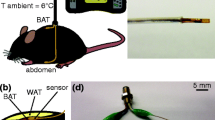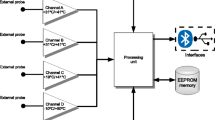Abstract
The early diagnosis of microbial infection is critical to the clinical instigation of effective post-exposure prophylaxis or therapy. However, diagnosis of infection is often attempted only when there are overt clinical signs, and for some of the serious human pathogens, this may jeopardise the efficacy of therapy. We have used a miniaturised sealed, implantable transponder incorporating a calibrated temperature sensor with an external receiver system, to monitor core body temperature (Tc) remotely. We have observed early changes in the diurnal rhythm of Tc, after infection of mice with bacterial pathogens. Changes in Tc preceded overt clinical signs by 3–10 h following challenge with Yersinia pestis, which causes acute infection, In contrast, changes in Tc were detected 11 days before clinical signs in mice exposed to Burkholderia pseudomallei, which causes a chronic syndrome. Significantly, mice pre-vaccinated against Y.pestis infection showed only slight and transient disruption to the diurnal rhythm for Tc, in the absence of clinical signs, when challenged with 106 median lethal doses of Y.pestis. This remote monitoring technology could be used to monitor changes in more than one physiological parameter and extrapolation of these data to the clinic would define the available therapeutic window in which diagnosis and post-exposure prophylaxis could be instigated, after a suspected exposure.







Similar content being viewed by others
References
T. Atkins, R.G. Prior, K. Mack, P. Russell, M. Nelson, P.C.F. Oyston, G. Dougan, and R.W. Titball, Infect. Immun. 70, 5290 (2002).
D. Brooks, R.L. Horner, L.F. Kozar, T.K. Waddell, C.L. Render, and E.A. Phillipson, J. Appl. Physiol 81, 1012 (1996).
Y. Cohen, F. Bahri, J. Bruneau, M. Dubuis, N. Dubuis, L. Merlin, T. Michaud, and S. Peysson, Intl. J. Nucl. Med. Biol. 12, 477 (1986).
J.F. Cooper, Progress in Clin Biol Res. 29, 345 (1979).
H.S. Crofts, S. Wilson, N.G. Muggelton, D.J. Nutt, E.A.M. Scott, and P.C. Pearce, Clin Neurophysiol 112, 2265 (2001).
J.P. Filkins, N.R. Di Luzio, Proc. Soc. Exp. Biol. Med. 129, 724 (1968).
H.H. Freedman, J. Exp. Med. 111, 453 (1960).
G.G. Greer and E.T. Rietscjhel, Infect. Immun. 19, 357 (1978).
G.D. Griffiths, R.J. Hornby, D.J. Stevens, E.A.M. Scott, and D.G. Upshall, J. Appl. Toxicol. 21, 59 (2001).
K. Kramer and L.B. Kinter, Physiol. Genomics 13, 197 (2003).
M.S. Lever, M. Nelson, P.I. Ireland, A.J. Stagg, R.J. Beedham, G.A. Hall, G. Knight, and R.W. Titball, J. Med Micro 52, 1109 (2003).
T.M. Mann, P.C. Pearce, B.A. Reed, E.J. Badcock, and E.A.M. Scott, Proceedings of the 16th International symposium on Biotelemetry, Vienna/Austria May 6–11 (2001).
H. Mumford and J.R. Wetherell, J. Neurosci. Methods 107, 125 (2001).
M. Nelson, J.L. Prior, S.M. Lever, H.E. Jones, T.P. Atkins, and R.W. Titball, J. Med. Micro 53, 1177 (2004).
P.C. Pearce, H.S. Crofts, S. Wilson, N.G. Muggleton, and E.A.M. Scott, Monitoring sleep in non-human primates by means of radiotelemetry. Proceedings of the 16th International symposium on Biotelemetry, Vienna, Austria May 6–11 (2001).
B.A. Reed, E.J. Badcock, H. Mumford, J.R. Wetherell, and E.A.M. Scott, A novel minimally invasive device for recording temperature in groups of freely-moving rodents housed under laboratory conditions. Proceedings of the 16th International symposium on Biotelemetry, Vienna/Austria May 6–11 (2001).
R.C. Ristuccia and L.P. Spear, Ann N.Y. Acad. Sci. 1021, 445 (2004).
V. Ruggiero, C.M. D’Urso, C. Albertoni, S. Campo, P. Foresta, and E.A. Martelli, Mediators of Inflammation 2, S43 (1993).
P. Russell, S.M. Eley, S.E. Hibbs, R.J. Manchee, A.J. Stagg, and R.W. Titball, Vaccine 13, 1551 (1995).
V.L. Savage, Remote monitoring in biocontainment. LASA winter meeting UK 2004.
C.R. Schnell and P. Gerber, Prim. Rep. 49, 61 (1997).
E.A.M. Scott and R.N. Hollands, Monitoring home cage activity in rats over 24 hours. Proceedings of the Fifth FELASA Symposium Brighton (1993), pp. 364–374.
J.A. Splawinski, E. XZacny, and Z. Gorka, Pflugers Arch. 38, 125 (1977).
J. Wang, T., Ando, and A.J. Dunn, Neuroimmunomodulation 4, 230 (1997).
A.C. Wardlaw, L. Boorman, and R. Reid, Br. J. Exp. Pathol. 52, 198 (1971).
J. Wetherell, M. Price, and H. Mumford, NeuroToxicology 27, 485 (2006).
E.D. Williamson, S.M. Eley, K.F. Griffin, M. Green, P. Russell, S.E.C. Leary, P.C.F. Oyston, T. Easterbrook, K.M. Reddin, A. Robinson, and R.W. Titball, FEMS Immun. Med. Micro. 12, 223 (1995).
E.D. Williamson, H.C. Flick-Smith, C.S. LeButt, C.A. Rowland, S.M. Jones, E.L. Waters, R.J. Gwyther, J. Miller, P.J. Packer, and M. Irving, Infect. Immun 73, 3598 (2005).
G. Yaa, J. Wolinksi, and R. Zablieski, J. Vet Med 51, 106 (2004).
Acknowledgments
Expert technical assistance from Warren Kitchen, Naomi Clayton and Dr. S.A. Watts is gratefully acknowledged. The development of the remote monitoring technology with application to refinement of existing procedures was supported by a grant from the UK Home Office APC Research and Alternatives Sub-Committee.
Author information
Authors and Affiliations
Corresponding author
Rights and permissions
About this article
Cite this article
Williamson, E.D., Savage, V.L., Lingard, B. et al. A biocompatible microdevice for core body temperature monitoring in the early diagnosis of infectious disease. Biomed Microdevices 9, 51–60 (2007). https://doi.org/10.1007/s10544-006-9007-5
Published:
Issue Date:
DOI: https://doi.org/10.1007/s10544-006-9007-5




